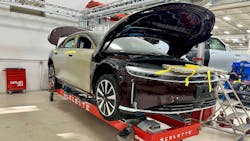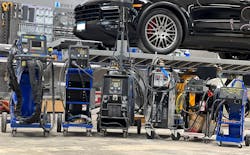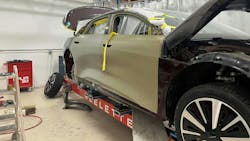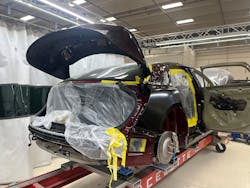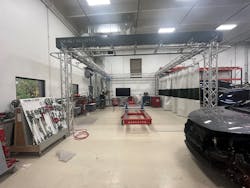Almost four years ago, I wrote an article titled “Value in OEM Certification.” The article gave an overview of what a collision repair business, particularly an MSO, would look at in terms of equipment requirements and costs, education requirements, certification fees, paint and material requirements, parts purchasing requirements, inspections, audits, dealership relationships, and more. I won’t go into all the details. If you wish to read it, here is a link: Value in OEM certification | FenderBender and ABRN
What I will cover is how these programs have been changing.
OEM shop certification evolution
Today, there are more programs than in the past. Toyota only recently started including independent shops (versus only dealership shops) in their program. The new electric vehicle (EV) manufacturers have collision repair certification programs (sometimes referred to as networks).
As in the past, many programs start with a dealership relationship. Many vehicle manufacturers require the endorsement of a dealer to start the application process. Some manufacturers do have other ways of starting the application process, often by communicating with program managers, sometimes linked on a website.
Equipment requirements have become more challenging. There has been some relief of the redundancy of each manufacturer requiring specific brands of tools, which may be similar to other brands that perhaps another manufacturer specifies. Some OEMs recognize this and provide more than one option, sometimes based on a specific performance standard. But in the big picture, if you wish to have many certification programs you will experience at least some redundancy in terms of equipment like frame racks, measuring equipment, rivet tools, welders, and misc. hand tools.
Education requirements have become more demanding. There are more classes required for more shop positions. Most of the training is online. But there are many required classes at the OEMs’ training sites, which require travel and lodging. Staffing shortages and the competitive job market complicate the topic because so many certifications require various shop positions to each have certain levels of training. When someone leaves, it creates a big challenge to get the shop back into compliance.
Overall, certification compliance has become much more challenging. Many manufacturers have more frequent and more thorough audits and inspections. Some look for evidence that OEM scan tools are used for pre and post scans. Some look for evidence of exclusive use of OEM parts. Some are starting to look at shop processes, such as complete teardowns and blueprinting, as requirements. They are checking for use of crash wrap and other forms of vehicle protection. Some require the consistent use of OEM repair procedures and check to be certain that the shop gets them directly from the OEM. Some require battery disconnection in some or all repairs.
Clean room requirements for alternative metalwork, especially aluminum, are becoming more common and stricter.
Some OEMs require the use of an OEM certification site and monitor for regular log-in.
Some manufacturers have additional aspects of certification that may be part of their collision repair programs or may reside next to them. I am referring to specific certifications for glass work, ADAS work, and EV work.
We are seeing a trend toward more parts restrictions. In other words, OEMs will only sell certain parts, often key structural parts, to certified shops.
The costs to become certified have grown. There are a few programs that are more simplistic and less expensive. But those are becoming fewer. Most programs are becoming more demanding and expensive. Annual fees, software fees, equipment costs, and training costs are all much higher than in the past. For the most part, the high-end brands and models come with the most cost. I know of at least one vehicle brand that, if you don't already have any of the equipment or training, will cost roughly $300,000 in equipment, training, and fees to become certified.
So, as these programs become more demanding and costly, is there an upside? I believe there are many. Most importantly, it’s all about repairing the vehicle properly and providing safety. Certified shops get the newest and most thorough repair training and information. More and more customers are concerned about safe and proper repairs. More are inclined to seek certified shops than in the past. People recognize the increased vehicle cost and vehicle complexity, and they understand that repair complexity is increasing accordingly. And more than ever they are concerned about the personal safety of themselves, families, and other passengers. And there are more advantages that I will cover later.
Have DRPs reached a tipping point?
DRPs came on the scene in the 1980s and became prevalent in the 1990s. In the beginning, participating shops were required to have a modest level of training and equipment. There were some modest concessions required, often including competitive pricing and commitments to provide estimating, customer communication, prompt service, and in some cases preferential treatment. In exchange, insurers referred customers. Consolidators used DRPs for rapid growth. Insurer influence over repairers increased dramatically.
Over the years, there were more and more requirements added. I know of some cases where insurers were surprised at how willing repairers were to make more concessions and accept more claim handling responsibilities. Free total-loss estimating and vehicle evaluation would be a classic example. Others include an array of alternative parts usage, prescribed automated parts price sourcing and procurement requirements, and parts price-shopping requirements. Some programs “incentivize” repairers to achieve specific KPI thresholds with financial incentives or financial penalties. More and more administrative burdens were added. Then, some consolidators negotiated their own unique DRP programs with some insurers, discouraging other repairers.
Fast forward to today, and it appears that DRPs have reached a tipping point. Many repairers have concluded that (at least some) of the insurers have gone too far in their demands. Some repairers have become frustrated over how some DRP relationships have evolved from more of a partnership to a ‘master/servant’ style relationship. Repairer operating costs have dramatically increased, not only from inflation but also due to staffing shortages. There are fewer shops due to consolidation, staffing issues, and increased operating challenges, some due to increased vehicle complexity. Recently accident frequency has been high, and work is plentiful. The national average for shop backlog has been running over four weeks. As more and more repairers have ventured away from at least some DRP programs, they’ve discovered that they haven’t lost as much work as they feared. And their profit margins improved as they were no longer under the pricing constraints of a DRP. Even some of the consolidators who have been the biggest supporter of DRPs have been willing to separate from some DRPs in an effort to gain margin, especially higher labor rates, to compensate for increased costs.
I know of one high profile industry expert who regularly says, “DRPs are dying a slow death”.
The perfect storm
According to a 2023 survey of 600 shops by CRASH Network, 38 percent of surveyed shops had no DRPs over the last year or more. That’s up from 33 percent in 2022 and 30 percent in 2021. Among those surveyed who participated in DRPs, 27 percent said they had fewer DRPs than a year before. Only 12 percent had more DRPs.
The robust collision repair market gives repairers some comfort and courage in taking steps to minimize or eliminate their participation in DRPs. I believe changing consumer perspectives contributes as well. Thanks to online reviews and less trust in institutions such as insurance companies, consumers are less likely to accept the shop recommendation of an insurer without doing some research. Online reviews and the advice of friends and family have tremendous influence. As a result, when a shop departs from a DRP today, the negative impact is often much less than in the past. Many repairers are getting away from the presumption that they must have DRPs to get business, and instead returning to marketing and good customer relationship practices to gain business, just as was done in the past and is done by most other industries.
All of these factors evolving around a strong marketplace and frustrations with DRPs have created an environment conducive to minimizing or eliminating participation in DRPs.
And now consider the influence of OEM certification programs. While I believe they haven’t caused the decline of DRPs, they certainly have contributed to it.
Despite the increasing complication and expense of participating in OEM certification programs, they offer many benefits. As I mentioned before, they provide an “inside track” to be among the first to gain the ability to repair vehicles with the latest technologies. Thus, a shop gains the ability to perform the safest and most proper repairs, which is what we should all be striving for. There is an increasing awareness and concern for safety within the motoring public that complements the concept of OEM certifications. The vehicle manufacturers, with and through their certification programs, are taking more control of first notice of loss (FNOL). Some even have automated and other communication strategies that quickly interact with vehicle drivers/owners after a collision and in some cases immediately recommend specific certified shops. As more and more OEMs are getting into the auto insurance business, their influence with vehicle owners increases and directs more repair work to certified shops. I’ve personally seen data indicating significant increases in the influence of OEM certification programs on the vehicle owner’s decision-making process when choosing a shop.
The current collision repair marketplace has become the perfect storm to allow shops to venture away from DRPs and to witness their diminishment. The increased prevalence of OEM certification is among the key factors creating it, and thus providing a new path for many repairers to follow.
About the Author
Darrell Amberson
Vice president of industry and OEM relations
Darrell Amberson is the vice president of industry and OEM relations at Quality Collision Group.
Previously, he was president of operations for LaMettry's Collision, a 10-location multi-shop operator in the Minneapolis area purchased by Quality Collision Group in November 2024. Amberson has more than 40 years of collision industry experience and served as chairman of the Collision Industry Conference for the 2021-2022 term, as well as interim chairman for the first two CIC meetings of 2024.
